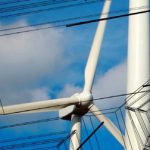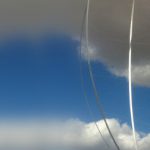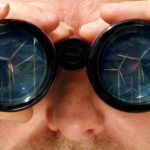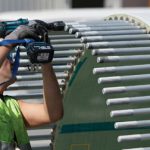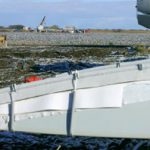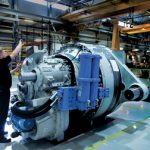It is widely believed in the wind industry that improvements in yaw control can only produce a small improvement in output power. This belief simultaneously exists with an acknowledgment that attempting to measure wind characteristics in the turbulent post-rotor wind is problematic.
BlueScout Technologies has shown, on a variety of turbines, that power increases can be achieved when improved wind angle information is fed into the yaw control systems of turbines. However, this early work typically uses the legacy control strategy of the turbine. In truth, turbine manufacturers have invested considerable time and thought into developing yaw control strategies that compensate for the errors of the post-rotor measurement system. However, those strategies typically include long averaging times and allow considerable variance in yaw before correcting the yaw angle of the turbine.
Accurately measuring the incoming wind properties, with dramatically reduced noise, means that different control strategies can be considered for yaw control. Put simply, beyond the gains achieved by simply feeding better information into the legacy control system, how much extra power can really be generated by employing control strategies that take advantage of the improvement in wind information?
This work takes real data from an operating turbine under the yaw control of the BlueScout Optical Control System (OCS). The summary describes the methodology used in the simulation and the results of the parametric study for the two control parameters of wind direction moving average time and yaw direction threshold. Power performance increases and turbine yaw actuation times are presented. For unlimited yaw activity, a power increase of about 6 percent is demonstrated. If yaw activity is limited to 8 percent, it was found that an additional 3 percent power gain may be achieved with settings for the site/turbine installation evaluated in the study at a moving average time for the wind direction of 60 seconds and a yaw direction threshold of 8 degrees.
Methodology
A simulation was developed in order to estimate optimal control parameters for the OCS. The simulation and model were developed in MATLAB and Simulink, the model being presented in Figure 1. The design of this controller model was based on existing turbine yaw algorithms: The system utilizes a moving average of the wind direction as measured by the nacelle anemometry and begins yawing when the moving average exceeds a specific threshold. The turbine continues to yaw until the moving average of the direction error is zero degrees. Both the moving average time and the direction error threshold are parameters in the simulation.
The input to the simulation is the sum of the OCS measured wind direction on an operational wind turbine (wind direction relative to the nacelle) and the turbine nacelle position. This sum is a measure of the wind direction relative to north, and represents the wind field to which the turbine is exposed in time. The data utilized to run these simulations is real data from an installation of a BlueScout OCS on an operational turbine. The data set includes OCS variables, such as wind speed and direction, as well as the nacelle orientation and power production.
The simulation models how this actual turbine will react to this changing wind field based on the turbine’s yaw rate, and the two parameters of moving average time and yaw error threshold. The output of the simulation is the yaw actuation of the turbine and an estimate of the local wind direction error to which the rotor is exposed. The yaw actuation data allows for calculation of number of yaw events and time yawing. The wind field measurements from the OCS upwind of the turbine are propagated to the turbine assuming a constant convection velocity equal to the mean velocity of the sample data being processed. Utilizing the wind from north data and the current simulated nacelle position, and assuming the time to convect to the rotor from the OCS measurement locations, a local rotor wind direction error can be calculated. This data allows for statistics of the instantaneous yaw error and estimates of power production to be determined. Power production is modeled as the cos3 of the local rotor wind direction error. This relationship comes from the argument that the effective wind speed for power production is the cube of the normal component of the wind to the rotor. The relative power production is proportional to cos3 of the wind direction error, so the cos3 of the convected wind direction error is the metric for performance increase in this study.
Results
A parametric study was conducted using the simulation for a variety of moving average times and yaw threshold values. The simulation assumes that the power produced by the turbine is proportional to the cos3 of the wind direction error at the rotor, so this value is used as the metric for power performance improvement. Results of this study can be seen in Figure 2 and Figure 3. Figure 2 demonstrates how the cos3 of the yaw error varies with the two-parameter settings. Figure 3 demonstrates how the fraction of yawing time changes with the two-parameter settings. In looking at these curves, as the moving average time is decreased and the yaw dead-band is tightened, both the relative power captured and the amount of time yawing increase. This is as expected: the turbine is more accurately tracking the wind, especially smaller turbulent scales, such that the local rotor wind direction error is reduced, but at the cost of much more yaw actuation. Figure 2 also demonstrates that there is an upper limit to this benefit in power capture given the upwind nature of the measurements. Once the moving average time becomes small enough, the phase lag this introduces is smaller than the convection time from the OCS measurement volume, such that the controller is introducing an error by yawing too soon. This is more evidence that these studies should be more rigorous in being done at specific speed regimes, and that the parameter settings will probably be optimized with a scheduling routine to account for this phase issue.
Given these results, a recommend set of parameters where there is moderate power performance gain, while limiting the increase in yaw actuation, would put the moving average time around 60 seconds, and the yaw direction threshold at 8 degrees. This would be an increase in power performance of roughly 3 percent while changing the time yawing from about 5 percent of time yawing to roughly 8 percent. Again, performing this study while focusing on differing wind regimes would be beneficial, as a representative power curve showing the relative increase with scheduled parameters could also be developed.
Note that this is optimization of the OCS. The OCS has greatly improved performance over legacy control systems with existing nacelle anemometry at any of the parameter settings in the range demonstrated in this study.
Discussion and Further Work
The results presented here are mean results over all wind speeds. The model for power performance of the cos3 of the wind direction error is only applicable below rated power. The performance increase may vary depending on wind speed. The simulation could be run taking speed regimes in to account, which may lead to scheduling of parameters for different wind speeds.
This simulation is run using local wind data and turbine characteristics. Parameters may vary by time of year (seasonal weather patterns), or by nominal wind direction (local properties – terrain, etc. – which may affect turbulence), as well as for turbine model (unique yaw rates). A schedule of parameters could be developed if optimal parameters were found to vary for these changing conditions (such as scheduling by wind sector). Historical MET data from the original site assessment could be utilized to do this work, but this would ignore the local affects the turbine has on the inflow wind. The data used for this study had the benefit of an OCS installed on an operational wind turbine, so blockage/induced flow effects are present in the real inflow measured data.
This simulation is based on a simple turbine control algorithm. More advanced algorithms could be developed and implemented. The same processes as described in this study could be utilized, where the Simulink model has more capability. More complexity could also be added for scheduling yaw rates (variable yaw rate machines), as well as scheduling the given parameter settings. The overall algorithm could also be modified, where the simple on/off relay model is replaced. Manufacturers could also modify the physical yaw actuation systems to allow for different control strategies, such that the controller is not limited by the amount of time yawing. This research is currently ongoing in order to best utilize the novel optical control system. Implementation of such algorithms is relatively simple, as these are simply software changes in existing control hardware implementations.





















